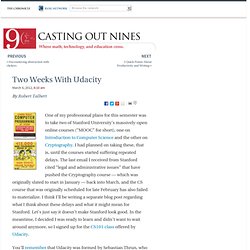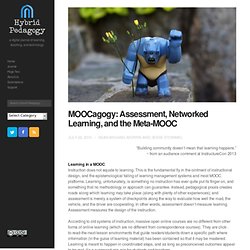

MOOCs and the Gartner Hype Cycle: A very slow tsunami. By Jonathan Tapson On September 13, 2013 A lot can change in a year.

Twelve months ago, the traditional universities were doomed, condemned to irrelevance by an onslaught of MOOCs. Not every last one of them was going to die; Sebastian Thrun said that perhaps ten might survive. This was not very reassuring for the executives, staff, students, and alumni of the 20,000 universities which don’t fall into the top-10, when ranked according to the criterion: “Universities which will survive MOOCs.” We haven’t yet seen this category in the Times Higher Ed rankings, but we are sure its appearance is imminent.
One year later, it seems that, like Mark Twain’s, reports of these deaths are greatly exaggerated. Experienced observers of technology will recognize this as a familiar stage in a cycle. The Hype Cycle is pretty straightforward. Fig. 1: The Gartner Hype Cycle Some questions we need to ask in terms of MOOCs are: Are MOOCs going to go through the full Hype Cycle? But does it matter? MOOC Production Values: Costs, Approaches and Examples. At every MOOC-related event I attend, I meet people who say they want to teach online classes.

Most are affiliated with a university or school, and often some plans seem imminent, but I rarely hear about new courses sprouting up outside of the most high-profile MOOC platforms. For all the interest in MOOCs, there is precious little guidance for teachers on how to produce them. I hope to give some good examples to follow here. Even for students, it’s worth watching how MOOCs are produced with an eye on the educational goals, production elements and the resources employed. Designing and Running a MOOC. What is a MOOC? Two Weeks With Udacity - Casting Out Nines. One of my professional plans for this semester was to take two of Stanford University’s massively-open online courses (“MOOC” for short), one on Introduction to Computer Science and the other on Cryptography.

I had planned on taking these, that is, until the courses started suffering repeated delays. The last email I received from Stanford cited “legal and administrative issues” that have pushed the Cryptography course — which was originally slated to start in January — back into March, and the CS course that was originally scheduled for late February has also failed to materialize. I think I’ll be writing a separate blog post regarding what I think about these delays and what it might mean for Stanford. Let’s just say it doesn’t make Stanford look good. In the meantime, I decided I was ready to learn and didn’t want to wait around anymore, so I signed up for the CS101 class offered by Udacity.
The CS101 class focuses on Python and consists of seven one-week units. Image: How NOT to Design a MOOC: The Disaster at Coursera and How to Fix it. I don’t usually like to title a post with negative connotations, but there is no way to put a positive spin on my experience with the MOOC I’m enrolled in through Coursera, Fundamentals of Online Education: Planning and Application.

The course so far is a disaster, ‘a mess’ as numerous students have called it. Ironically, the learning outcome of the course is to create our own online course. To be fair, there are some good points to the course, but there are significant factors contributing to a frustrating course experience for students, myself included. Group Chaos There are three key factors contributing to this course calamity and all link to the group assignment. The first, a ‘technical glitch’ was big enough to cause one of Google’s servers to crash. The course started Monday, January 28, 2013 and problems began on day one when participants were instructed to ‘join a group’. What happens When Group Work Goes Haywire This course will be collaborative in nature. Online Courses Look for a Business Model. MOOCagogy: Assessment, Networked Learning, and the Meta-MOOC. “Building community doesn’t mean that learning happens.” ~ from an audience comment at InstructureCon 2013 Learning in a MOOC Instruction does not equate to learning.

This is the fundamental fly in the ointment of instructional design, and the epistemological failing of learning management systems and most MOOC platforms. Learning, unfortunately, is something no instruction has ever quite put its finger on, and something that no methodology or approach can guarantee. Instead, pedagogical praxis creates roads along which learning may take place (along with plenty of other experiences); and assessment is merely a system of checkpoints along the way to evaluate how well the road, the vehicle, and the driver are cooperating. In other words, assessment doesn’t measure learning. This, though, is like putting a lion in a cage and training it to jump through burning hoops: the lion tamer may master the beast in captivity, but this will not make him master of the African savannah. Warming Up to MOOC's.
[This is a guest post by Douglas H.

Fisher, an associate professor of computer science and of computer engineering at Vanderbilt University. --@jbj] In Fall 2011, Stanford announced three, free massively open online courses, or MOOCs. Two of these courses, database and machine learning, corresponded to spring 2012 courses that I would be teaching at Vanderbilt University. I recognized that I could use the lecture materials from these classes to “flip” my own classes by having students view lectures before the class meeting, which then could be used for other learning activities. Nonetheless, I decided that not using these high quality materials because of insecurity was silly. In both classes, students took a quiz at the start of each class on the online lecture material and readings. The experience in the machine learning class, in particular, suggested the utility of what I call a “wrapper” around a MOOC.